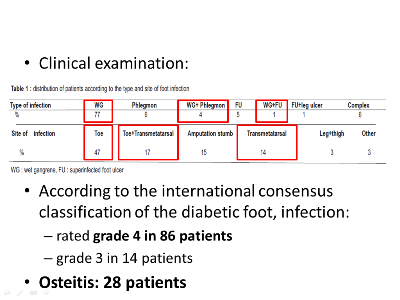
Mehdi Khalfallah
Charles Nicolle’s Hospital, Tunisia
Title: Which germs should be targeted in diabetic foot infection? A prospective study of 100 patients
Biography
Biography: Mehdi Khalfallah
Abstract
Background & Aim: Identifying the infecting bacterial flora is one of the main rules to be followed to ensure the success of antibiotherapy in the treatment of the infected diabetic foot. The aim of the work was to define the bacteriological profile of the bacteria causing the infection of the diabetic foot at the Surgery Unit B of Charles Nicolle’s Hospital in Tunis and determine the prognostic factors of this condition.
Methods: It was an open prospective study. It concerned 100 diabetic patients operated on for diabetic foot infection. All patients had bacteriological samples taken through deep scraping and swabbing carried out in the operating room.
Results: The average age of patients was 59.5±11 years, with a sex ratio of 2:4. The foot infection was represented in 82% of cases by a wet gangrene. The enterobacteria were the most frequently isolated bacteria (73%), followed by Streptococcus (10%), Staphylococcus aureus (9%). The rate of multidrug-resistant bacteria was of 9.5%. The empiric antibiotic therapy used (fusidic acid+amoxicillin/clavulanic acid) was inactive on 44.1% of the isolated bacteria. When we compared the group of patients with unfavorable development (who have been re-operated) and the group of patients with favorable development, we have found two poor prognosis factors: arteritis (p=0.018; OR=23.7) and presence of multidrug-resistant bacteria (p=0.027; OR=5.8).
Conclusion: The enterobacteria were the main bacteria causing the infection of diabetic foot. The prognostic factors found, arteritis and isolation of multidrug-resistant bacteria; outpoint the importance of multidisciplinary care.



